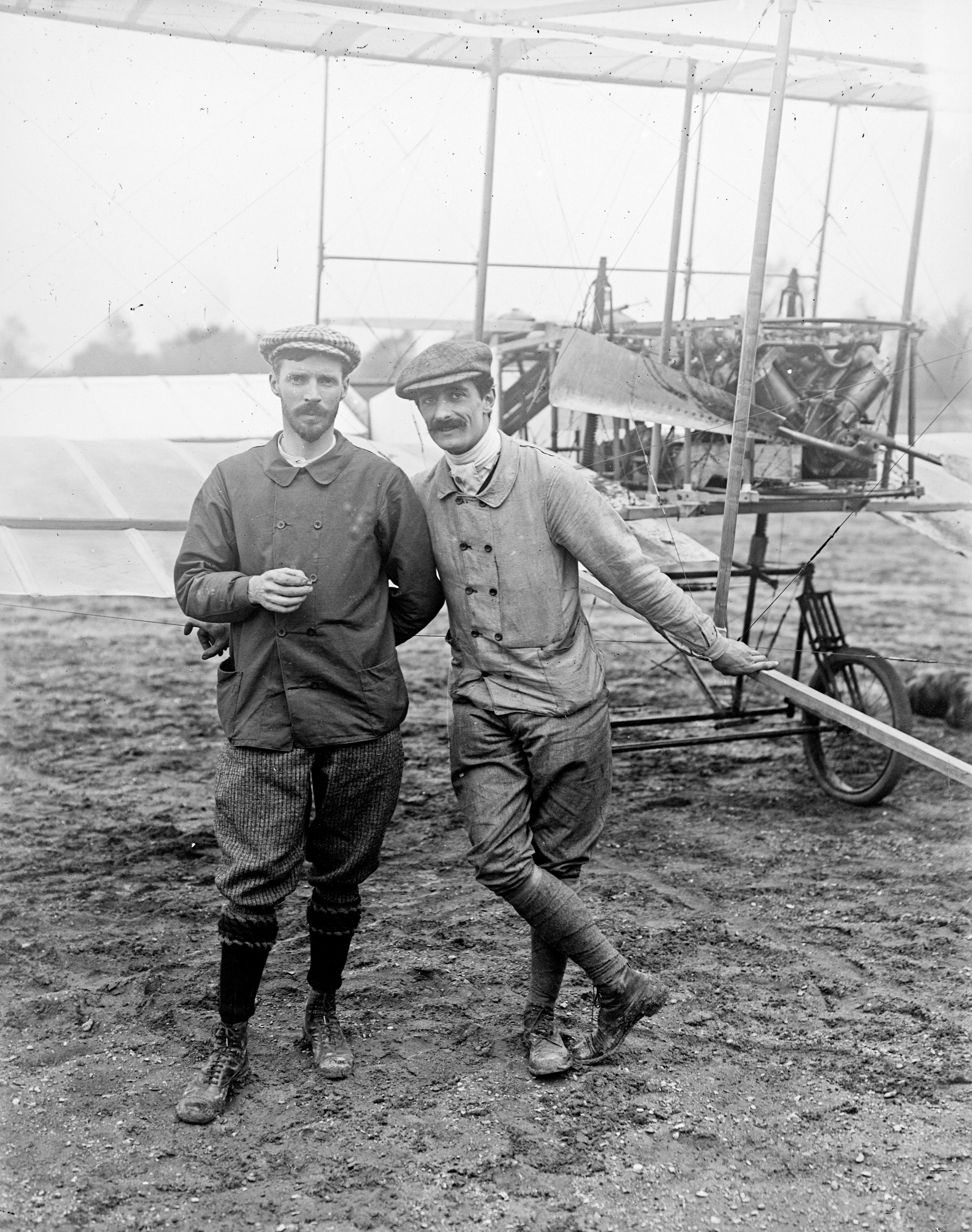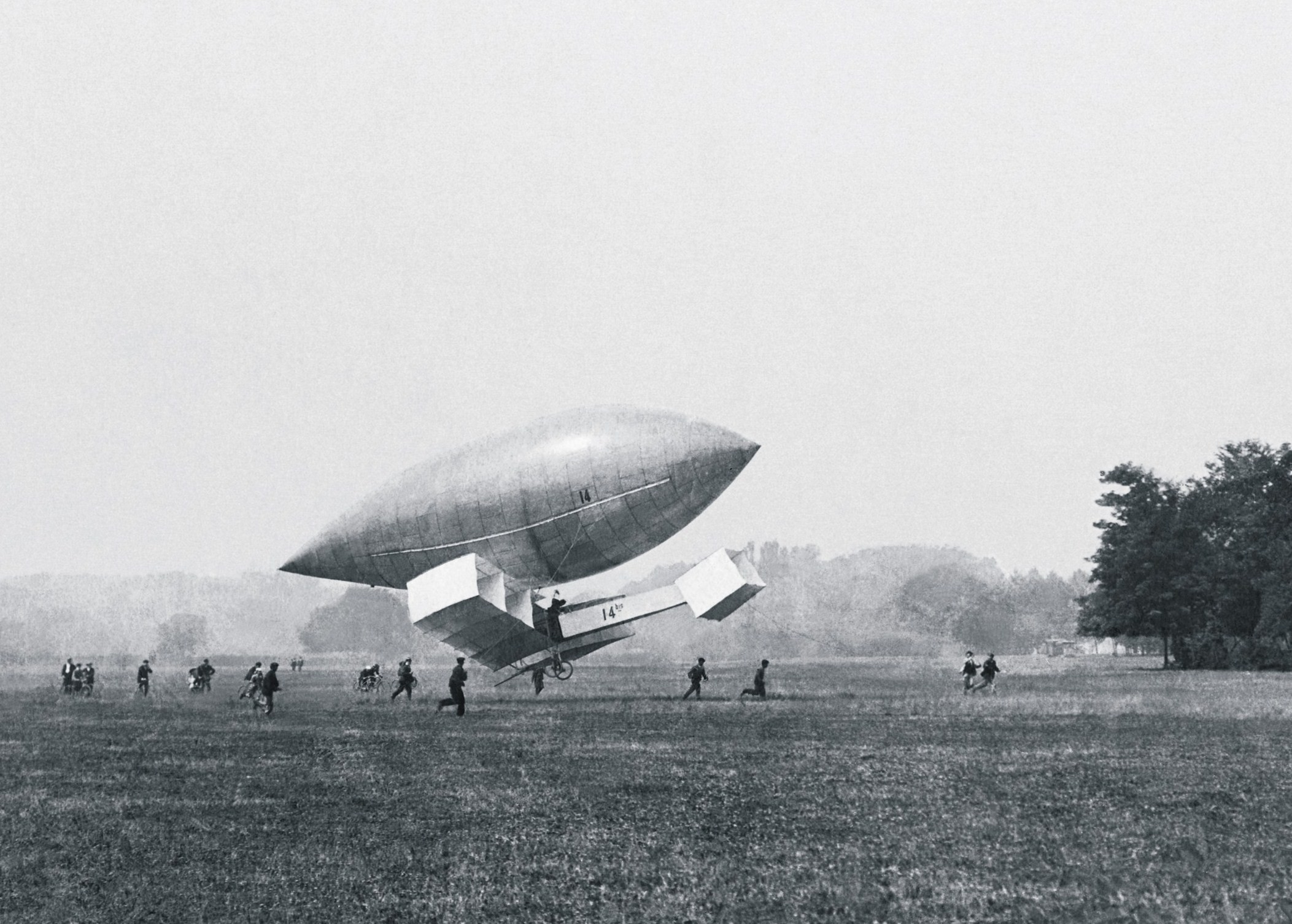|
Gabriel Voisin
Gabriel Voisin (5 February 1880 – 25 December 1973) was a French aviation pioneer and the creator of Europe's first manned, engine-powered, heavier-than-air aircraft capable of a sustained (1 km), circular, controlled flight, which was made by Henry Farman on 13 January 1908 near Paris, France. During World War I the company founded by Voisin became a major producer of military aircraft, notably the Voisin III. Subsequently, he switched to the design and production of luxury automobiles under the name Avions Voisin. Early life Gabriel Voisin was born on 5 February 1880 in Belleville-sur-Saône, France, and his brother Charles Voisin, two years younger than him, was his main childhood companion. When his father abandoned the family his mother, Amélie, took her sons to Neuville-sur-Saône, where they settled near her father's factory. Their grandfather, Charles Forestier, took charge of the boys' education with military rigor. The boys also went for expeditions along th ... [...More Info...] [...Related Items...] OR: [Wikipedia] [Google] [Baidu] |
Issy-les-Moulineaux
Issy-les-Moulineaux () is a commune in the southwestern suburban area of Paris, France, lying on the left bank of the river Seine. Its citizens are called ''Isséens'' in French. It is one of Paris' entrances and is located from Notre-Dame Cathedral, which is considered Kilometre zero of France. On 1 January 2010, Issy-les-Moulineaux became part of the ''Grand Paris Seine Ouest'' agglomeration community, which merged into the Métropole du Grand Paris in January 2016. Issy-les-Moulineaux has successfully moved its economy from an old manufacturing base to high value-added service sectors and is at the heart of the Val de Seine business district, the largest cluster of telecommunication and media businesses in France, hosting the headquarters of most major French TV networks. Name Originally, Issy-les-Moulineaux was simply called Issy. The name Issy comes from Medieval Latin ''Issiacum'' or ''Isciacum'', perhaps meaning "estate of Isicius (or Iccius)", a Gallo-Roman lando ... [...More Info...] [...Related Items...] OR: [Wikipedia] [Google] [Baidu] |
Antoinette (manufacturer)
Antoinette was a French manufacturer of light petrol engines. Antoinette also became a pioneer-era builder of aeroplanes before World War I, most notably the record-breaking monoplanes flown by Hubert Latham and René Labouchère. Based in Puteaux, the Antoinette concern was in operation between 1903 and 1912. The company operated a flying school at Chalons for which it built one of the earliest flight simulators. Private engine-building venture Antoinette began as a private venture led by the engineer Léon Levavasseur and financed by Jules Gastambide, who owned an electricity generating station in Algeria. While on holiday with Gastambide and his family in 1902, Levavasseur expressed his interest in the emerging field of aviation and proposed the development of light, powerful engines for use in aircraft. Levavasseur then suggested to Gastambide's daughter, Antoinette, that the engines should be named after her. Gastambide financed the venture. Levavasseur patented the ... [...More Info...] [...Related Items...] OR: [Wikipedia] [Google] [Baidu] |
Flyer III
The Wright Flyer III was the third powered aircraft by the Wright Brothers, built during the winter of 1904–05. Orville Wright made the first flight with it on June 23, 1905. The Flyer III had an airframe of spruce construction with a wing camber of 1-in-20 as used in 1903, rather than the less effective 1-in-25 used in 1904. The new machine was equipped with the engine and other hardware from the scrapped Flyer II and, after major modifications, achieved much greater performance than Flyers I and II. Design and development The 1905 flyer was made stronger, more durable, and with a longer tail to provide better directional stability and control. A larger cylinder bore engine provided more power, while a more effective leading edge, and efficient propellers, improved performance. The propeller blades were made wider and thinner, while according to Harry Combs, "...adding a backward sweep to the blades, calculated precisely to avoid the pressures of flight and to keep th ... [...More Info...] [...Related Items...] OR: [Wikipedia] [Google] [Baidu] |
Le Mans
Le Mans (, ) is a city in northwestern France on the Sarthe River where it meets the Huisne. Traditionally the capital of the province of Maine, it is now the capital of the Sarthe department and the seat of the Roman Catholic diocese of Le Mans. Le Mans is a part of the Pays de la Loire region. Its inhabitants are called ''Manceaux'' (male) and ''Mancelles'' (female). Since 1923, the city has hosted the 24 Hours of Le Mans, the world's oldest active endurance sports car race. History First mentioned by Claudius Ptolemy, the Roman city ''Vindinium'' was the capital of the Aulerci, a sub tribe of the Aedui. Le Mans is also known as ''Civitas Cenomanorum'' (City of the Cenomani), or ''Cenomanus''. Their city, seized by the Romans in 47 BC, was within the ancient Roman province of Gallia Lugdunensis. A 3rd-century amphitheatre is still visible. The '' thermae'' were demolished during the crisis of the third century when workers were mobilized to build the city's defensi ... [...More Info...] [...Related Items...] OR: [Wikipedia] [Google] [Baidu] |
Appareils D'Aviation Les Frères Voisin
Aéroplanes Voisin was a French aircraft manufacturing company established in 1905 by Gabriel Voisin and his brother Charles, and was continued by Gabriel after Charles died in an automobile accident in 1912; the full official company name then became ''Société Anonyme des Aéroplanes G. Voisin''Gunston, 1993, says the full name was "Aéroplanes G. Voisin". On the other hand the avions-voisin.org webpage specifies the name as "Société Aéroplanes Voisin, Société Anonyme". ( en, Aeroplanes Voisin public limited company). During World War I, it was a major producer of military aircraft, notably the Voisin III. After the war Gabriel Voisin abandoned the aviation industry, and set up a company to design and produce luxury automobiles, called Avions Voisin. Early History Gabriel Voisin had been employed by Ernest Archdeacon to work on the construction of gliders and then entered into partnership with Louis Blériot, to form the company ''Ateliers d' Aviation Edouard Surco ... [...More Info...] [...Related Items...] OR: [Wikipedia] [Google] [Baidu] |
Gabriel Voisin And Henry Farman
In Abrahamic religions ( Judaism, Christianity and Islam), Gabriel (); Greek: grc, Γαβριήλ, translit=Gabriḗl, label=none; Latin: ''Gabriel''; Coptic: cop, Ⲅⲁⲃⲣⲓⲏⲗ, translit=Gabriêl, label=none; Amharic: am, ገብርኤል, translit=Gabrəʾel, label=none; arc, ܓ݁ܰܒ݂ܪܺܝܐܝܶܠ, translit=Gaḇrīʾēl; ar, جِبْرِيل, Jibrīl, also ar, جبرائيل, Jibrāʾīl or ''Jabrāʾīl'', group="N" is an archangel with power to announce God's will to men. He is mentioned in the Hebrew Bible, the New Testament, and the Quran. Many Christian traditions — including Anglicanism, Eastern Orthodoxy, and Roman Catholicism — revere Gabriel as a saint. In the Hebrew Bible, Gabriel appears to the prophet Daniel to explain his visions (Daniel 8:15–26, 9:21–27). The archangel also appears in the Book of Enoch and other ancient Jewish writings not preserved in Hebrew. Alongside the archangel Michael, Gabriel is described as the guardi ... [...More Info...] [...Related Items...] OR: [Wikipedia] [Google] [Baidu] |
Santos-Dumont 14-bis
The ''14-bis'' (french: Quatorze-bis), (), also known as ("bird of prey" in French), was a pioneer era, canard-style biplane designed and built by Brazilian aviation pioneer Alberto Santos-Dumont. In 1906, near Paris, the ''14-bis'' made a manned powered flight that was the first to be publicly witnessed by a crowd. Background In June 1905, French aviator Gabriel Voisin had flown a glider towed by a fast boat on the river Seine, making a flight of over . The glider's wing and tail were made up of Hargrave cells, a box kite-like structure that provided a degree of inherent stability. This established the Hargrave cell as a configuration useful not only for kites but also for heavier-than-air aircraft. Santos-Dumont was living in Paris at the time, and was one of the most active "aeronauts" in Europe, having developed a series of non-rigid airships that displayed unparalleled agility, speed, endurance, and ease of control. Santos-Dumont met Voisin at the end of 1905, and commi ... [...More Info...] [...Related Items...] OR: [Wikipedia] [Google] [Baidu] |
Alberto Santos-Dumont
Alberto Santos-Dumont ( Palmira, 20 July 1873 — Guarujá, 23 July 1932) was a Brazilian aeronaut, sportsman, inventor, and one of the few people to have contributed significantly to the early development of both lighter-than-air and heavier-than-air aircraft. The heir of a wealthy family of coffee producers, he dedicated himself to aeronautical study and experimentation in Paris, where he spent most of his adult life. He designed, built, and flew the first powered airships and won the Deutsch Prize in 1901, when he flew around the Eiffel Tower in his airship No. 6, becoming one of the most famous people in the world in the early 20th century. Santos-Dumont then progressed to powered heavier-than-air machines and on 23 October 1906 flew about 60 metres at a height of two to three metres with the fixed-wing 14-bis (also dubbed the ''Oiseau de Proie''—"bird of prey") at the Bagatelle Gamefield in Paris, taking off unassisted by an external launch system. On 12 November in ... [...More Info...] [...Related Items...] OR: [Wikipedia] [Google] [Baidu] |
National Air And Space Museum
The National Air and Space Museum of the Smithsonian Institution, also called the Air and Space Museum, is a museum in Washington, D.C., in the United States. Established in 1946 as the National Air Museum, it opened its main building on the National Mall near L'Enfant Plaza in 1976. In 2018, the museum saw about 6.2 million visitors, making it the fifth-most-visited museum in the world, and the second-most-visited museum in the United States. In 2020, due to long closures and a drop in foreign tourism caused by the COVID-19 pandemic, museum attendance dropped to 267,000. The National Air and Space Museum is a center for research into the history and science of aviation and spaceflight, as well as planetary science and terrestrial geology and geophysics. Almost all spacecraft and aircraft on display are originals or the original backup craft. The museum contains the Apollo 11 Command Module ''Columbia'', the ''Friendship 7'' capsule which was flown by John Glenn, Charles Li ... [...More Info...] [...Related Items...] OR: [Wikipedia] [Google] [Baidu] |




.jpg)


